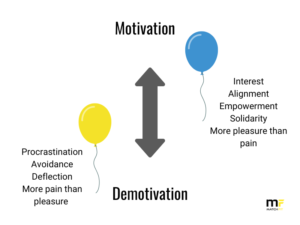The continuous loop of motivation is a powerful driver for success and achievement once you and your team are in its flow. But if a lack of motivation is the challenge you’re tackling, what steps can you take to build motivation in yourself, and others? In this first of a two-part series, we look at self-motivation.
The use of the word motivation can be traced back to its German form in 1854. Originally, it was considered a singular determinant of human thoughts, feelings, and actions. However, it was soon apparent that motivation operates with other determinants as well, such as cognition, affect, habits.
But if we agree that motivation is a critical factor in the success of the individual and team, how do we actually address the challenge when it is clearly lacking?
Understanding what it is
First of all, it’s important to recognise that self-motivation and motivating others are two separate areas, which each require focus and dedication. And then we need to understand the factors that determine why motivation might be inherent in some individuals, but not in others. Much research has been published, and books written about the topic – indeed, Motivational Theory is a subject area that could keep you occupied for weeks, if not months!

In some circumstances, people are motivated because of an alignment with their interests, or their natural inclination towards certain goals, such as succeeding in their career. Equally powerful though, is the motivation to distance ourselves from something unenjoyable or unpleasant – for instance, the company culture that becomes so unbearable that the only option is to leave. Generally, we’re motivated either towards, or away from something.
One of the reasons our CLIMB programme works so well is that it aligns group motivation towards an agreed team goal while recognising that individual goals can be personal, and quite different from each other. Within the CLIMB analogy, some will be motivated to get to the summit, whilst others are content with reaching basecamp. Both will contribute to a successful team, as long as their motivations are understood, accepted and feed into the ultimate goal.
Environment and culture obviously has a significant influence. If we work in an organisation where we’re supported, listened to, respected and valued, we’re far more likely to feel motivated, and in turn, be more inclined to embrace the goals we’re set. When the opposite is true, our leaders are likely to meet more resistance.
But, assuming we’re not at those extremes, how do we motivate ourselves in an area that’s maybe not a natural inclination for us, but is important for us in terms of our performance? At MatchFit, we use the phrase ‘wishing, hoping or really wanting to’ to drill down into how much of a priority someone has really assigned to a task or goal. Sometimes, it’s about the pain-pleasure principle – finding that point where the pain of not doing something is worse than just getting it done. And that will be part of the phenomenological experience, different for everyone.
High performance, then, is about deciding where you need to be motivated in order to improve your performance, whether you feel motivated in those areas or not. How do you flick that switch?
Making motivation a strategy
A common mistake is not making motivation a strategy. It’s almost as if there’s an expectation that you’re either going to be motivated or not, and it’s other people’s responsibility, especially in the work environment, to make sure you’re motivated. But, outside of the sports industry, where motivation is a such a key driver for performance, you don’t often hear about the need to make self-motivation deliberate. Like any skill we want to learn, or behaviour we want to adopt, we need to develop motivation as a habit, a discipline in itself to be nurtured and grown, in order to develop and maintain the thinking, behaviours and attitudes that support our goals, wherever they are. Athletes achieve this by a combination of focusing on marginal gains, breaking goals down into smaller elements, and developing consequential thinking – looking at what they will lose if they don’t do that thing they don’t really want to do, and what they will gain if they do.
Motivating ourselves when we’re stuck
Sometimes, for example, we have to accept that while we’re in a job we don’t enjoy, the risk of leaving is greater. In that circumstance, how do you develop the skill set or exercise that muscle that actually makes you motivated to do well or enjoy that job more?
Recognising that while you might not be able to leave right now, you can choose to leave at some point in the future, is helpful. You can look at the individual aspects of the job – recognise what’s not so bad, even if it’s not enjoyable. Maybe you’ve got some autonomy, or once your job’s finished at five o’clock you can go home. Maybe you don’t have far to travel and your colleagues are nice people. You can shift your mindset from ‘I hate my job’ to accepting that it’s not forever and planning an exit strategy – what you can do today, right now, every day that moves you towards that goal.
Habits for improving self-motivation
- Make motivation a strategy
- Decide are you wishing, hoping or really wanting?
- Develop consequential thinking
- Define aligned goals
- Develop a pre-game routine to get started (we like this blog from James Clear) )
In part II, we’ll look at how we can inspire others to find and maintain their motivation, especially during challenging times.

